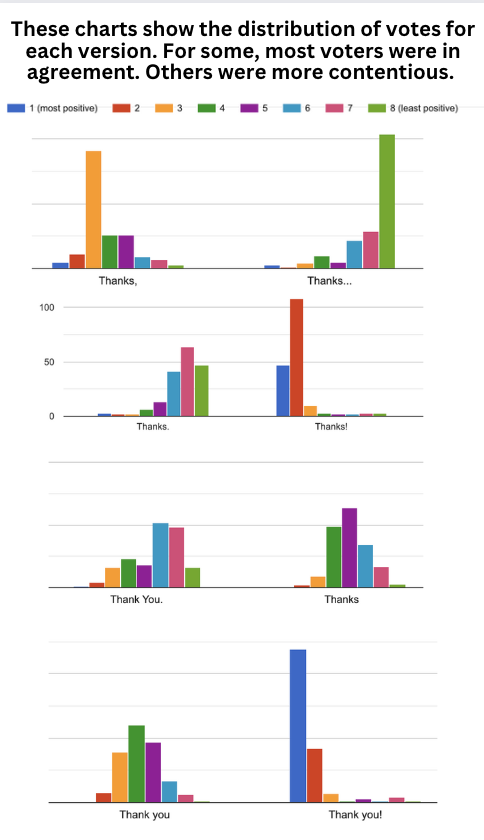Chapter 6: Perfecting Your Writing: Grammar
We’ve talked a lot about how word choice impacts tone, but there’s one sneaky element that can also impact how your reader perceives your tone: punctuation.
In January of 2023, I did an informal survey that I circulated through Twitter and other social media channels, asking people to rank different variations of the email sign-off “Thanks,”. I got the idea because every so often, debate flares up over whether some sign-offs are seen as passive-aggressive, rude or hostile.
Here were the instructions:
Please rank the following email sign-offs from most positive (1) to most negative (8). The sign-offs are:
-
Thanks.
-
Thanks!
-
Thanks,
-
Thanks…
-
Thank You.
-
Thanks
-
Thank you
-
Thank you!
How would you rank them? Why? Go with your gut reaction, then see how you did compared to others who took the poll.
The Results
So, which was the most positive and which was the least positive? 178 people took the survey. With one being the most positive and 8 being the least positive, here’s how they ranked the versions:
- Thank you! = 1.60
- Thanks! = 2.09
- Thanks, = 3.71
- Thank you = 4.27
- Thanks = 5.02
- Thank You. = 5.7
- Thanks. = 6.58
- Thanks… = 7.02
As you can see, some very interesting things are happening here! What trends do you notice? Did anything surprise you?
I noticed:
- Exclamation points are seen as positive, which likely isn’t surprising.
- Adding a comma to ‘Thanks’ made it more positive (3.71 vs. 5.02). In general, versions without punctuation were seen as more negative than versions with punctuation.
- A period at the end of ‘Thanks’ was seen as more negative.
- The ellipsis (…) is seen as the most negative, likely because it comes across as passive-aggressive.
- With an exclamation point at the end, ‘thank you’ is seen as more positive than ‘thanks.’ However, the opposite was true without punctuation and with a period. Hmm!
Finding the most confusing sign off
However, we can also see that some email sign-offs were more contentious than others. These charts show the distributions of the scores. I’ve put the data in a couple of different formats.
Based on this information, which sign-off do you think is the most confusing? Why?
Note: the alt text for all of the charts are in the first image.

Thanks, has a few votes for most positive and least positive. However, there’s a huge spike of votes for 3 and a few more for 4 and 5.
Thanks.. has very few positive votes. There’s a huge spike at the least positive, and small number of votes in the 6th and 7th place
Thanks. Has practically no votes until the 4th place. However, the votes are distributed fairly equally between 6th, 7th and 8th place, with a spike on 7th.
Thanks! Has the most votes in the #2 position, and then about half that number in the #1 position, and basically no votes elsewhere.
Thank You. Has a distribution of around 20 votes or 3, 4 and 5, about 40 votes for 6 and 7 and about 20 votes for 8
Thanks has no extremely positive or negative votes. The most votes (around 70) are for #4, but there are about 60 votes for #5
Thank you has has no extremely positive or negative votes. It has about 30 votes for #3, 50 for #4, 35 for #5 and then a few for #6 and 7
Thank you! Has nearly all #1 votes, and then maybe 30 for #2. A few people had it in some of the negative columns.
So what does this mean?
Well, it means that punctuation impacts how readers interpret the tone. Some types of punctuation, such as exclamation points and ellipses, are rather straightforward. However, when it comes to no punctuation, commas and periods, we know that readers interpret them differently.
This doesn’t mean that you should obsess over every single comma you write. It just illustrates how many choices we have when we create a particular tone, and how sometimes how others perceive our messages will be different from what we intend because of a different context. It’s also worth noting that all of our tone choices take place within a larger context. Your relationship with the reader, the type of communication you’re sending, the purpose of the message and the genre will influence how the reader interprets these subtle clues about your tone.

